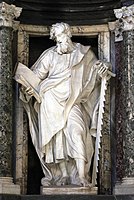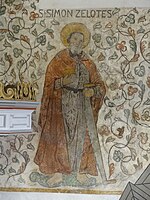Simon the Zealot
Ethiopian Christianity) July 1 (medieval Hispanic liturgy as attested by sources of the time, such as the Antiphonary of León) | |
|---|---|
| Attributes | boat; cross and saw; fish (or two fish); lance; man being sawn in two longitudinally; oar[2] |
| Patronage | curriers; sawyers; tanners[2] |
Simon the Zealot (Acts 1:13, Luke 6:15) or Simon the Canaanite or Simon the Canaanean (Matthew 10:4, Mark 3:18;
Identity
The name Simon occurs in all of the
Simon, (whom he also named Peter,) and Andrew his brother, James and John, Philip and Bartholomew, Matthew and Thomas, James the son of Alphaeus, and Simon called Zelotes, And Judas the brother of James, and Judas Iscariot, which also was the traitor.
The Zealot
To distinguish him from
Robert Eisenman has argued that contemporary talmudic references to Zealots refer to them as kanna'im "but not really as a group—rather as avenging priests in the Temple".[6] Eisenman's broader conclusions, that the zealot element in the original apostle group was disguised and overwritten to make it support the assimilative Pauline Christianity of the Gentiles, are more controversial. John P. Meier argues that the term "Zealot" is a mistranslation and in the context of the Gospels means "zealous" or "religious" (in this case, for keeping the Law of Moses), as the Zealot movement apparently did not exist until 30 to 40 years after the events of the Gospels.[7] However, neither Brandon[8] nor Hengel[9] support this view.
Other identifications
In the gospels Simon the Zealot is not directly identified with Simon the brother of Jesus mentioned in Mark 6:3:
Is not this the carpenter, the son of Mary and brother of James and Joses and Judas and Simon, and are not his sisters here with us?" And they took offense at him.
The
-
James Tissot, Saint Simon, Brooklyn Museum
-
Statue of Saint Simon in theArchbasilica of Saint John Lateranby Francesco Moratti.
-
The Apostle Simon the Zealot by Georg Gsell
-
Simon Zelotes evangelische Kirche Leihgestern
-
Statue of Simon the Zealot by Hermann Schievelbein at the roof of the Helsinki Cathedral
Later tradition



Isidore of Seville drew together the accumulated anecdotes of Simon in De Vita et Morte.
According to
In the apocryphal
In later tradition, Simon is often associated with
Another tradition states that he traveled in the
Yet another tradition says he visited Roman Britain. In this account, in his second mission to Britain, he arrived during the first year of Boadicea's rebellion (60 AD). He was crucified 10 May 61 AD by the Roman Catus Decianus, at Caistor, modern-day Lincolnshire, Britain.[19] According to Caesar Baronius and Hippolytus of Rome, Simon's first arrival in Britain was in the year A.D. 44, during the Roman conquest.[19] Nikephoros I of Constantinople writes:[19][20]
Simon born in Cana of Galilee who for his fervent affection for his Master and great zeal that he showed by all means to the Gospel, was surnamed Zelotes, having received the Holy Ghost from above, travelled through Egypt, and Africa, then through Mauretania and all Libya, preaching the Gospel. And the same doctrine he taught to the Occidental Sea, and the Isles called Britanniae.
Another tradition, doubtless inspired by his title "the
The second century
In Islam, Muslim exegesis and Quran commentary name the twelve apostles and include Simon amongst the disciples.
In art, Simon has the identifying attribute of a saw because according to tradition he was martyred by being sawn in half.[11]
Sainthood
Simon, like the other Apostles, is regarded as a saint by the
References
- ^ "St. Simon the Apostle" (in Italian). Blessed Saints and Witnesses. 2005-03-15. Retrieved 29 March 2010.
- ^ a b c Jones, Terry H (6 January 2009). "Saint Simon the Apostle". Saints.SQPN.com. Retrieved 29 March 2010.
- ^ "Saint Simon". st-takla.org (in Arabic).
- JSTOR 1087656.
This work [De viris illustribus], as he reveals at its start and finish, was completed in the fourteenth year of Theodosius, that is, between 19 January 392 and 18 January 393.
- ^ "Archived copy". Archived from the original on 2023-04-01. Retrieved 2023-05-20.
{{cite web}}: CS1 maint: archived copy as title (link) - James the Brother of Jesus: The Key to Unlocking the Secrets of Early Christianity and the Dead Sea Scrolls. Viking Penguin. pp. 33–34.
- ISBN 978-0-300-14032-3.
- ^ a b Brandon, S.G.F. (1967). Jesus and the Zealots: A Study of the Political Factor in Primitive Christianity. Manchester University Press.
- ^ ISBN 978-0-567-29372-5.
- ^ Bechtel, Florentine Stanislaus (1907). . In Herbermann, Charles (ed.). Catholic Encyclopedia. Vol. 2. New York: Robert Appleton Company.
- ^ a b Löffler, Klemens (1912). . In Herbermann, Charles (ed.). Catholic Encyclopedia. Vol. 13. New York: Robert Appleton Company.
- ^ Appendix to the Works of Hippolytus 49.11
- ^ de Voragine, Jacobus (1275). The Golden Legend or Lives Of The Saints. Retrieved 28 October 2018.
- ^ a b c Stracke, Richard. Golden Legend: Life of SS. Simon and Jude. Retrieved 28 October 2018.
- ^ The Arabic Gospel of the Infancy of the Saviour.
- ISBN 9781317031895.
- ^ "St. Simon of Zealot". Catholic Online. Retrieved 29 March 2010.
- ^ "St. Jude Thaddeus and St. Simon the Zealot, Apostles". catholicnewsagency.com. Catholic News Agency. Retrieved 29 July 2021.
- ^ ISBN 978-0-85205-008-8.
- ^ Cornelius a Lapide, Argumentus Epistoloe St. Pauli di Romanos, ch. 16.
- ^ "Epistula Apostolorum". Early Christian Writings. Retrieved 29 March 2010.
- ISBN 978-0810843059.
Muslim exegesis identifies the disciples of Jesus as Peter, Andrew, Matthew, Thomas, Philip, John, James, Bartholomew, and Simon
- ^ "The Calendar". The Church of England. Retrieved 2021-03-27.
External links
- All appearances of "Simon" in the New Testament (mostly referring to Simon Peter)
- Legenda Aurea: Lives of Saints Simon and Jude
- "St. Simon the Apostle" in the Catholic Encyclopedia
- "Ὁ Ἅγιος Σίμων ὁ Ἀπόστολος ὁ Ζηλωτής". Megas Synaxaristis (in Greek).






